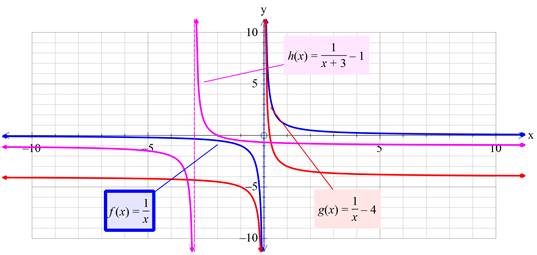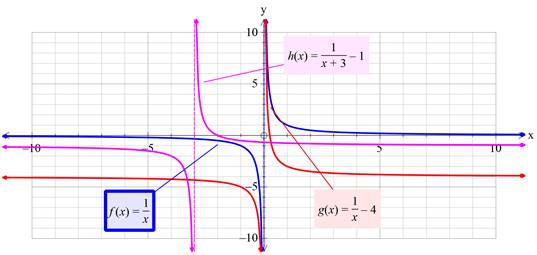
To sketch the graph of the given functions on same co-ordinate system
Explanation of Solution
Given:
The given functions are:
Calculation for graph:
Consider
| Values of x | Values of f (x ) |
| 1 | 1 |
| 2 | 0.5 |
| 3 | 0.33 |
| 4 | 0.25 |
| 5 | 0.2 |
By taking different values of x , the graph can be plotted.
Calculation for graph:
Consider
| Values of x | Values of g (x) |
| 1 | -3 |
| 2 | -3.5 |
| 3 | -3.67 |
| 4 | -3.75 |
| 5 | -3.8 |
By taking different values of x , the graph can be plotted.
Calculation for graph:
Consider
| Values of x | Values of h (x ) |
| 2 | -0.8 |
| 3 | -0.83 |
| 4 | -0.86 |
| 5 | -0.875 |
| 6 | -0.888 |
By taking different values of x , the graph can be plotted.
Graphs on the same co-ordinate system:

Verification:
Using graphing utility to draw the graph of given functions,

Interpretation:
From above graph, it is clear that, the drawn sketch and above graph are identical to each other.
Here,
Chapter 1 Solutions
EP PRECALC.GRAPHING APPR.-WEBASSIGN-1YR
 Calculus: Early TranscendentalsCalculusISBN:9781285741550Author:James StewartPublisher:Cengage Learning
Calculus: Early TranscendentalsCalculusISBN:9781285741550Author:James StewartPublisher:Cengage Learning Thomas' Calculus (14th Edition)CalculusISBN:9780134438986Author:Joel R. Hass, Christopher E. Heil, Maurice D. WeirPublisher:PEARSON
Thomas' Calculus (14th Edition)CalculusISBN:9780134438986Author:Joel R. Hass, Christopher E. Heil, Maurice D. WeirPublisher:PEARSON Calculus: Early Transcendentals (3rd Edition)CalculusISBN:9780134763644Author:William L. Briggs, Lyle Cochran, Bernard Gillett, Eric SchulzPublisher:PEARSON
Calculus: Early Transcendentals (3rd Edition)CalculusISBN:9780134763644Author:William L. Briggs, Lyle Cochran, Bernard Gillett, Eric SchulzPublisher:PEARSON Calculus: Early TranscendentalsCalculusISBN:9781319050740Author:Jon Rogawski, Colin Adams, Robert FranzosaPublisher:W. H. Freeman
Calculus: Early TranscendentalsCalculusISBN:9781319050740Author:Jon Rogawski, Colin Adams, Robert FranzosaPublisher:W. H. Freeman
 Calculus: Early Transcendental FunctionsCalculusISBN:9781337552516Author:Ron Larson, Bruce H. EdwardsPublisher:Cengage Learning
Calculus: Early Transcendental FunctionsCalculusISBN:9781337552516Author:Ron Larson, Bruce H. EdwardsPublisher:Cengage Learning





